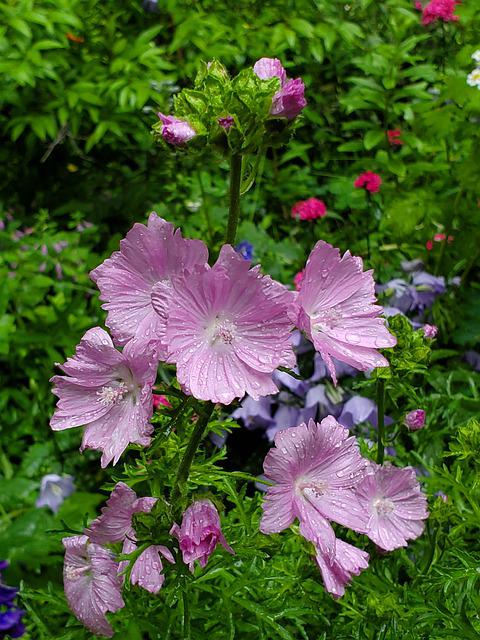What if I told you there was a tropical plant that could thrive in Northern U.S. climates? This isn’t a myth as the Hibiscus Moscheutos aka Swamp Rose Mallow plant can do just that – providing your plant world with beautiful color.
Once you’ve mastered the techniques of Hibiscus Moscheutos care, it can be a great addition to your plant collection for years to come.
What is a Hibiscus Moscheutos
The Hibiscus Moscheutos is a perennial plant that is wet and cold tolerant. Whereas many plants we cover are native to Africa, Asia or India the Swamp Rose Mallow is actually native to Southern to Eastern North America.
They can be found growing from Texas, then along the U.S. East Coast, and finally up to Southern Canada. They are a steady fixture in many state parks along these regions.
The Hibiscus Moscheutos can grow to almost 8 feet tall. When bloomed, the large flowers can easily get as large as 9 inches wide and range in colors of red, pink, and white.
Other Names for Hibiscus Moscheutos

There are many common names for the Hibiscus Moscheutos, such as the hardy hibiscus, rose mallow, swamp rose-mallow, crimsoneyed rosemallow, and eastern rosemallow.
Quick Hibiscus Moscheutos (Swamp Rose Mallow) Fact Chart
| Other Names | Rose mallow, swamp rose-mallow, crimsoneyed rosemallow, hardy hibiscus and eastern rosemallow |
| Plant Family | Malvaceae |
| Type | Herbaceous Perennial |
| Native Region | Southern to Eastern North America |
| Blooming Period | July to September |
How to Care For Hibiscus Moscheutos (Best Tips)
Hibiscus Moscheutos care will be considerably easy if you already live in their native region along the Eastern Coast of North America. However, you can have a thriving plant in any locale if you pay attention to these key tips for care of the Swamp Rose Mallow.
Light
Hibiscus Moscheutos plants prefer full sun but can also do well in part shade. If they experience low light, the flower production won’t be the best and the stems can be weakened. Not having full sun can also make them more susceptible to plant diseases.
Climate
The Hibiscus Moscheutos thrives and flowers best in moist, humid conditions, ranging in temperature from 65-75 degrees Fahrenheit. A study conducted by researchers at Michigan State University found 73℉ to be the sweet spot.
A humidity level of 50% or more is best. If you’re unsure of your humidity level, consider purchasing a plant hygrometer that measures the level of humidity in the air. The Swamp Rose Mallow aka Hibiscus Moscheutos is rated to grow in USDA hardiness zones 5-9.
Watering
Hibiscus Moscheutos are wetland plants and will need to be deeply watered, especially during the initial growing season. If not, the optimal, deep root system will not develop.
If an inch down into the plant soil is dry, watering is needed. It is not uncommon to water these guys on a daily basis, especially in drier climates.
Soil
The soil used for Hibiscus Moscheutos should be medium to fine in granular composition. As stated above, the soil needs to maintain a moist to wet condition. Heavy mulching during the summer months can benefit the roots by protecting them from the sun, thereby locking in moisture and coolness.
A rich, organic soil is preferred as these are the native conditions particular to this plant species. You can purchase a great organic soil like FoxFarm Ocean Forest Potting Soil. You can also use any sandy garden soil and add store-bought compost or make your own compost as I do.
Related Article: What Not To Put In a Compost Tumbler
Fertilizing
Hibiscus moscheutos care in regards to feeding and fertilization begins during the growing season (approximately April – June). During this time, your plant will benefit from a slow-release fertilizer like Osmocote Smart-Release applied every couple of weeks.
Pruning
Pruning the hibiscus moscheutos follows the care of most flowering hibiscus plant varieties. Any dead or dying flowers should be removed once spotted (deadheaded).
Just prior to winter or late autumn, it isn’t uncommon for seasoned swamp rose mallow growers to cut their plant stems back nearly to the ground (approximately 3 – 4 inches). Do not fear as this process stimulates new growth when things pick back up in spring.
Our Final Thoughts
Hibiscus Moscheutos care can be much easier if you have an area that is naturally moist such as around a pond or water feature. However, if you follow these tips your plant can thrive as long as you can adjust the plant’s environment as suggested. You’ll know you’ve done an awesome job when you reap the rewards of beautiful pink, red or white flowers in the blooming season!
